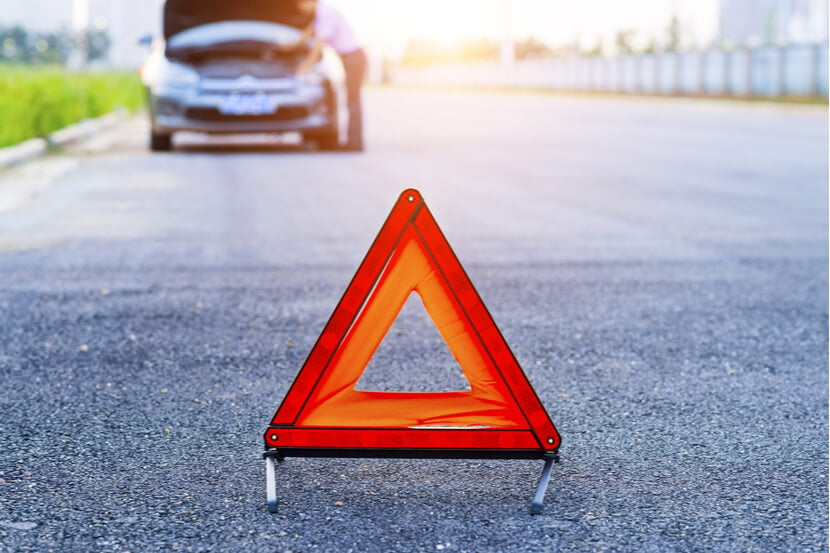If you've broken down and you're in a safe space, call your breakdown provider.
If you don't have break down cover, you can still call a breakdown company and ask for emergency assistance.
Here's more detail on what you should do if you breakdown in any other situation, for example on a motorway, a regular road or a car park.

What do I do if I break down on the motorway?
Here's what you do if you break down on a motorway:
- If you’re still able to drive the car, exit the motorway. This should make conditions much safer for you. Recovery vehicles can get to you more easily too.
- Turn on your hazard lights whether you've stopped or not. This tells other road users that you’re experiencing difficulties. Do this at all times of day, not just when it’s dark. If visibility is poor or you’re driving at night, turn on your front and rear sidelights too.
- If you can’t get off the motorway, pull over onto the hard shoulder and stop as far across to the left as possible. Turn your wheels to the left too.
- Use the doors furthest away from traffic to exit your vehicle. The driver should climb over into the passenger seat to get out. Put on high-visibility clothing if you have it.
- Wait outside of your car on the other side of the barrier that runs alongside the hard shoulder. Stand away from your car and at a few metres behind the rear of your car. This should help keep you safe if another vehicle hits your car.
- Use your phone to contact a breakdown service or local garage for assistance.
If for any reason you can’t use your own phone to call for help, you can use an emergency phone on the motorway.
The direction of the nearest phone should be indicated by arrows on the posts supporting the hard shoulder barrier.
If you have broken down on a motorway with no cover, you can still contact breakdown companies to come and rescue you. It just might be more expensive.
What should I do if I break down on a smart motorway?
Smart motorways have emergency refuge areas (ERAs) which are situated roughly every mile and a half. These are used instead of the hard shoulder which is sometimes used as a traffic lane.
Here's what you do if you breakdown on a smart motorway:
- Exit the motorway if possible. If you can't do this try to reach the next ERA.
- Turn on your hazard lights and sidelights if visibility is poor.
- If you can’t get off the motorway or to an ERA, get as far across to the left-hand side of the motorway as possible.
- If you can manage this, exit from the left of the vehicle. You night need to leave space between your car and the barrier in order to do so.
- Wait behind the barrier, well to the rear of the car, and call 999.
- If your car is broken down in a live lane and you can’t safely exit, stay inside with your seatbelt on and call 999.
If you reach an ERA, use the SOS phone located there to contact Highways England and report the problem. The agency should then arrange for you to be rescued.
As part of the additional safety measures on smart motorways, CCTV is used to check for breakdown.
If you’re spotted, the lane you are in should be closed to other traffic and rescue vehicles should be sent out automatically.
What shouldn't I do if I break down on a conventional or smart motorway?
Here's what you shouldn't do if you break down on a conventional or smart motorway:
- Don’t take pets out of the car. They are likely to be much safer inside the vehicle. On hot days, roll down the window a fraction to provide them with cooler air.
- Don’t put down a warning triangle. The speed of the other vehicles means it's too dangerous to do so – and it’s unlikely to be effective as a warning.
- Don’t attempt even basic repairs. Stay well away from your car, as there’s a significant risk of it being hit by another vehicle.
How far away should you put the warning triangle?
Around 45 metres is a good distance, but it may need to be a bit further away if you’re stopped round a bend. Remember, you shouldn't put your warning triangle out if you're on a motorway. And if you're on any other road, you should only put it out if it's safe to do this.
What should I do if I breakdown on any other type of road?
For any other road there are other key things to remember:
- If you can try to get away from the main flow of traffic. For example pull over into a lay by or into a quieter road.
- Use your hazard lights and sidelights to warn other motorists of the danger.
- Put on a high-visibility jacket or vest if you have one.
- Exit the car away from traffic if it's safe to do so. You can put a warning triangle behind your car but only if it's safe to do this.
- Call a breakdown service as soon as you're stopped and safe.
You should follow these steps for every road you break down on, but there are also specifics to remember for other sorts of road and driving situations:
A-roads or dual carriageways
For A-road and dual carriageways, you should also remember to:
- Wait outside your vehicle on the other side of the safety barrier.
- You should also stand a few metres behind the rear of your car.
Country roads
Danger could be less imminent on a country road as they're quieter. But it can also be more difficult to position your car safely away from other drivers. If you're broken down on a country road:
- Stay in the car if your vehicle isn’t causing an obstruction and can be seen clearly by other road users.
- If your car is blocking other traffic, call the police on the non-emergency 101 number. They might need to set up a diversion.
Roundabouts
If you've broken down at a roundabout, remember to:
- Try to get off the roundabout as soon as you can – even if it’s not the right exit. If this isn’t an option, try to stop near the left-hand edge of the roundabout away from an exit.
- If it’s safe to do so, get out of your car away from traffic, using the passenger door to exit to the edge of the roundabout.
Town or city centre road
If you're broken down in a city centre then it's worth also opening your bonnet so that other road users know you’ve broken down. This might make them more sympathetic than if they think you have just stopped to pick up a passenger, for example.
What do I do if I break down in a car park?
If you breakdown in a car park, it's worth following these steps:
- If you’re causing an obstruction you could ask for help pushing your vehicle to a parking space somewhere that's out of the way.
- Bear in mind that you could face parking charges while your car is there.
If possible make sure you have a valid ticket. If your car is going to be there for some time speak to a parking attendant or a member of staff where the car park is located.
Some car parks, such as those at supermarkets or motorway service stations, allow free parking but only for a limited period. Usually this is around two hours.
If your car is there for longer than this, you could get a parking charge notice (PCN) in the post.
Talk to staff to explain what’s happened and collect evidence that you’ve broken down. For example. a photo of your car being repaired or the invoice from your breakdown company.
This could help you challenge your parking fine if necessary.
What do I do if I break down at home?
If you have break down at home, also known as 'home start' or 'home rescue' you can call your breakdown provider. They will come out as soon as possible, or you can book in a time slot.
If you don't have cover you can call a breakdown company to fix your vehicle. This could be more expensive than a breakdown cover policy though.

